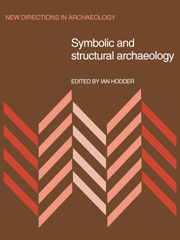Childe's offspring
Published online by Cambridge University Press: 27 February 2010
Summary
Anyone can use a book against itself, but since I am an interested advocate of the work in these chapters, I want to use some of the apparent discrepancies within the book to show, not its weakness, but its interior strengths. This book began as a conference on structuralism and symbolism in archaeology and appeared to owe its life to Lévi-Strauss and Edmund Leach: to Lévi-Strauss because of structuralism and to Leach (1973, pp. 761–71) because of his prediction that archaeology's next move would be to structuralism. The first discrepancy is that this book is not only not the advent of structuralism in archaeology, it may be the effective antidote needed to prevent that tired method long superceded even among its own practitioners. This book's archaeology supercedes, while simultaneously integrating, structuralism and does so at a time of great importance to archaeology. These archaeologists are not concerned with abstract principles of mind, as they would be if literal structuralists. But they are concerned with context, meaning and particular historical circumstances, as well as with the generative principles which unify particular cultures. They are interested in particular structures but within their historical, i.e. material, context.
The second apparent discrepancy occurs when we are invited to understand the archaeology presented here against the New Archaeology, particularly as defined by Lewis Binford. Systems theory, cross-cultural behavioural generalisations and Hempelian positivism, key aspects of the New Archaeology, are seen in the book as methodological errors to be avoided.
- Type
- Chapter
- Information
- Symbolic and Structural Archaeology , pp. 179 - 184Publisher: Cambridge University PressPrint publication year: 1982
- 12
- Cited by

